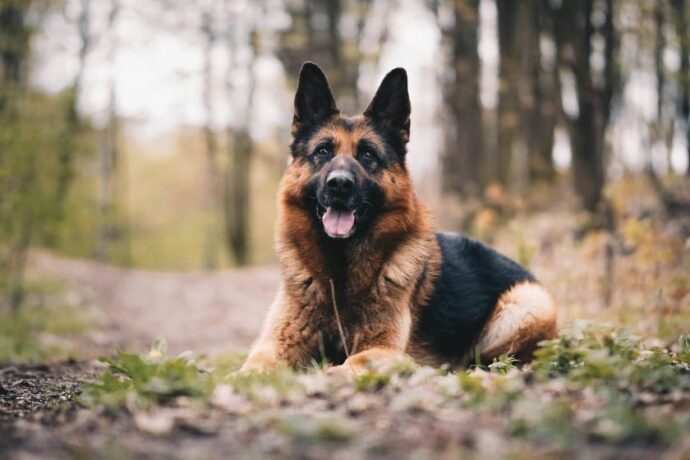
The Top Indicators You Need to Know
Your dog is your best friend and keeping them comfortable is your top priority — but sometimes it’s difficult to tell if your pup needs help. There are several key behaviors and physical signs to watch out for like subtle changes in appetite, reluctance to move, excessive licking or grooming of a specific area, and unusual vocalizations like whimpering or growling.
Additionally, you may even notice more obvious signs like limping, stiffness, or a sudden change in energy. By being vigilant and recognizing these signs early, you can seek timely vet care and ensure your dog receives the appropriate treatment. Understanding these indicators will help you safeguard your dog’s health and strengthen the bond you share with your furry friend.
Let’s take a look at some of the top signs that your dog is in pain.
1. Altered Eating Habits
What to look for: A sudden loss or increase of appetite in food and treats.
What to do: Monitor their eating habits for a few days, and consult your vet if the behavior persists.
A dog that’s experiencing pain may show a noticeable decline or complete loss of appetite. However, just as telling is a sudden increase in food intake or the tendency to avoid harder foods that require more effort to chew. Pain can make even the act of eating uncomfortable, especially if it stems from dental issues, gastrointestinal problems, or injuries. Be attentive to any abrupt changes in your dog’s eating patterns, as well as signs like dropping food from the mouth or chewing on one side, which could indicate a localized area of discomfort. If your dog’s eating habits have shifted dramatically, it’s essential to consult your vet to pinpoint the underlying cause. Prompt attention can not only alleviate your pet’s pain, but also prevent any further complications, ensuring a better quality of life for your furry friend.
2. Changes in Behavior
What to look for: Uncharacteristic aggression, anxiety, or lethargy.
What to do: Keep notes of these changes and share them with your vet.
Another important behavioral change to look out for is increased aggression or agitation. Dogs in pain can become more irritable and may snap or growl when touched, especially near the source of their discomfort. Your once friendly pet might suddenly cause defensive behaviors like guarding toys or food, or even avoiding interaction altogether. This is often a dog’s way of protecting themselves from further pain. Additionally, watch for changes in vocalization; excessive whining, whimpering, or howling can be clear indicators that something is wrong. If your normally quiet dog starts becoming more vocal without an obvious cause, it’s crucial to take these signs seriously and consult your veterinarian as soon as possible.
3. Vocalizations
What to look for: Increased whining, barking, or growling without a clear cause.
What to do: Gently try to identify the source of pain but avoid pressing too hard. Consult a vet immediately.
A telltale sign that your dog might be in pain is a noticeable change in their behavior or activity levels. If your dog is usually energetic and playful, then suddenly becomes lethargic or less enthusiastic about their favorite activities, it could be a red flag. Conversely, some dogs might exhibit restlessness and have difficulty settling down. Changes in sleep patterns, irritability, or withdrawal from social interactions commonly indicate that something is wrong. Monitoring and recognizing these changes can help you take swift action, ensuring your canine companion stays healthy and comfortable. Whether it’s a subtle shift in their routine or a drastic behavioral change, attentiveness to your dog’s overall demeanor is crucial in identifying pain early on.
4. Limping or Lameness
What to look for: Limping or an inability to put weight on a limb.
What to do: Rest the affected limb and consult a vet if the limping continues for more than a day.
Limping or lameness could result from various issues like arthritis, injuries, or even bone fractures. It’s crucial to observe whether your dog hesitates to put weight on a specific limb or appears to limp more severely after physical activity. Early detection and consultation with a veterinarian can help diagnose the underlying cause and provide appropriate treatment.
5. Changes in Posture
What to look for: Hunched back, lowered head, or an unwillingness to lie down.
What to do: Monitor their posture at different times of the day and schedule a physical exam with your vet.
One of the more subtle indications that your dog may be experiencing pain is a change in their posture which may include hunching their back, lowering their head, or being unwilling to lie down. Additionally, shifting from a relaxed stance to a guarded posture can indicate that your dog is protecting a painful area. Observing these changes is crucial, as dogs often mask their pain; subtle shifts in their body language can reveal a lot about their well-being and alert us to potential health issues.
6. Excessive Licking or Biting
What to look for: Focused licking or biting of a specific area.
What to do: Check for visible wounds or infections and consult your vet for an exam.
Excessive licking or biting can lead to other noticeable behaviors that indicate discomfort in your furry friend. When a dog fixates on a particular area, it may be attempting to soothe an injury, irritation, or underlying health issue. This behavior often reflects anxiety or stress as your dog tries to cope with their discomfort. For instance, if your dog is licking a specific paw or area of skin, it could be a sign that they have pain from an injury, infection, or allergies. Keep in mind that the repetitive nature of this behavior can lead to further skin damage or infection, creating a cycle of distress. Addressing the root cause of the pain can help alleviate your dog’s discomfort and prevent further complications.
7. Heavy Panting or Shivering
What to look for: Unexplained and prolonged panting or shivering, even when it’s not hot or cold.
What to do: Ensure your dog is in a comfortable temperature and consult a vet to rule out pain-related issues.
Heavy panting or shivering in dogs can be concerning signs that they may be in pain or distress. While panting is often associated with being hot or excited, excessive or sudden panting can indicate pain, particularly if it occurs in conjunction with other symptoms like restlessness or a change in behavior. Similarly, shivering or trembling can signal discomfort, anxiety, or pain, especially if your dog is not cold. Both behaviors can be a dog’s way of coping with physical discomfort or emotional stress, as they try to regulate their body’s response to pain.
8. Reluctance to Move
What to look for: Hesitance to jump, run, climb stairs, or go for walks.
What to do: Take note of specific activities causing discomfort and discuss them with your vet.
Reluctance to move can be one of the more significant indicators that your dog may be experiencing pain, but visible discomfort during movement isn’t the only sign. Changes in posture can also provide subtle clues that they’re hurting. As noted earlier, pay close attention to how your dog sits or lays down; a hunched back, difficulty rising, or a favoring of one side can all signal discomfort. Additionally, limping, stiffness, or frequently shifting positions might indicate joint pain or internal issues.
9. Unexplained Accidents
What to look for: Incontinence or accidents in house-trained dogs.
What to do: Rule out behavioral issues and talk to your vet to check for urinary tract infections or other pain-related issues.
Unexplained accidents in dogs, like urinating or defecating indoors, can often be a sign that they’re experiencing pain or discomfort. When your dog is in distress, they may lose control of their bodily functions due to anxiety or an inability to signal the need to go outside. Conditions like urinary tract infections, gastrointestinal issues, or injuries can contribute to these accidents, as your dog may associate pain with the usual process of elimination. Additionally, if your dog is reluctant to move or is in a compromised position due to pain, they might not make it outside in time.
10. Restlessness
What to look for: Inability to find a comfortable resting position, or continuous pacing.
What to do: Monitor for patterns in restlessness and seek veterinary advice to alleviate possible discomfort.
When a dog is unable to settle, frequently changing positions, pacing, or unable to relax, it may be a sign that they’re experiencing physical distress. Pain can make it difficult for your dog to find a comfortable position, leading to signs of agitation or anxiety. This behavior might also stem from underlying conditions, like arthritis, injuries, or internal issues that make it hard for them to stay still.
How to Help Your Dog When They’re in Pain
Recognizing these top signs your dog is in pain will ensure their health and happiness. To help a dog that’s in pain, try these steps.
Consult your veterinarian — Always consult with a vet to diagnose the problem accurately.
Provide comfort — Create a cozy sleeping area and ensure they have a quiet place to rest.
Try medication — Follow your vet’s guidance on medication that can alleviate pain or inflammation.
Consider diet and exercise — Maintain a balanced diet and discuss low-impact exercises that won’t exacerbate their condition.
Schedule regular check-ups — Regular veterinary visits can help catch issues early before they become severe.
Immediate consultation with a veterinarian and providing necessary care can make a significant difference in your pet’s quality of life. For more detailed information on each symptom, read comprehensive guides and consult veterinary resources online. Always remember, swift action can prevent long-term problems and help your dog enjoy a pain-free life.



